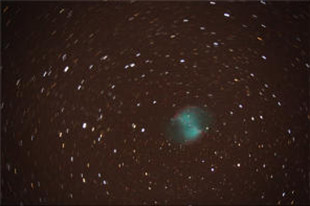
Astrophotography - When Things Go Wrong - Alt-Azimuth Mount Field Rotation
AZ Alt Mount Field Rotation
The following was retrieved from Wikipedia, the free encyclopedia, at en.wikipedia.org/wiki/Altazimuth_mount on February 28, 2016
Altazimuth mount
"An altazimuth or alt-azimuth mount is a simple two-axis mount for supporting and rotating an instrument about two mutually perpendicular axes – one vertical and the other horizontal. Rotation about the vertical axis varies the azimuth (compass bearing) of the pointing direction of the instrument. Rotation about the horizontal axis varies the altitude (angle of elevation) of the pointing direction.
These mounts are used, for example, with telescopes, cameras, radio antennas, heliostat mirrors, and solar panels, etc.
Several names are given to this kind of mount, including altitude-azimuth, azimuth-elevation and various abbreviations thereof.
When used as an astronomical telescope mount, the biggest advantage of an alt-azimuth mount is the simplicity of its mechanical design. The primary disadvantage is its inability to follow astronomical objects in the night sky as the Earth spins on its axis the way that an equatorial mount can. Equatorial mounts only need to be rotated about a single axis, at a constant rate, to follow the rotation of the night sky (diurnal motion). Altazimuth mounts need to be rotated about both axes at variable rates, achieved via microprocessor based two-axis drive systems, to track equatorial motion. This imparts an uneven rotation to the field of view that also has to be corrected via a microprocessor based counter rotation system. On smaller telescopes an equatorial platform is sometimes used to add a third "polar axis" to overcome these problems, providing an hour or more of motion in the direction of right ascension to allow for astronomical tracking. The design also does not allow for the use of mechanical setting circles to locate astronomical objects although modern digital setting circles have removed this shortcoming.
Another limitation is the problem of gimbal lock at zenith pointing. When tracking at elevations close to 90°, the azimuth axis must rotate very quickly; if the altitude is exactly 90°, the speed is infinite. Thus, altazimuth telescopes, although they can point in any direction, cannot track smoothly within a "zenith blind spot", commonly 0.5 or 0.75 degrees from the zenith. (I.e. at elevations greater than 89.25° or 89.5°.)"
The complete ( up-to-date ) Wikipedia article may be found at : en.wikipedia.org/wiki/Altazimuth_mount
The license terms of this written work from Wikipedia may be found at http://creativecommons.org/licenses/by-sa/3.0/
The following was retrieved from Wikipedia, the free encyclopedia, at
en.wikipedia.org/wiki/Astrophotography
on February 28, 2016
Astrophotography
"Astrophotography is a specialized type of photography for recording images of astronomical objects and large areas of the night sky. The first photograph of an astronomical object (the Moon) was taken in 1840, but it was not until the late 19th century that advances in technology allowed for detailed stellar photography. Besides being able to record the details of extended objects such as the Moon, Sun, and planets, astrophotography has the ability to image objects invisible to the human eye such as dim stars, nebulae, and galaxies. This is done by long time exposure since both film and digital cameras can accumulate and sum light photons over these long periods of time. Photography revolutionized the field of professional astronomical research, with long time exposures recording hundreds of thousands of new stars and nebulae that were invisible to the human eye, leading to specialized and ever larger optical telescopes that were essentially big cameras designed to collect light to be recorded on film. Direct astrophotography had an early role in sky surveys and star classification but over time it has given way to more sophisticated equipment and techniques designed for specific fields of scientific research, with film (and later astronomical CCD cameras) becoming just one of many forms of sensor.
Astrophotography is a large sub-discipline in amateur astronomy where it is usually used to record aesthetically pleasing images, rather than for scientific research, with a whole range of equipment and techniques dedicated to the activity."
The license terms of this written work from Wikipedia may be found at
http://creativecommons.org/licenses/by-sa/3.0/
- Activities for the Amateur Astronomer
- Astrophotography article on the Photo Gallery page
- Beginning Lunar Photography
- A Half Century of Astrophotography
- Astrophotography - Tips from Sky and Telescope
- Astrophotography by Jerry Lodriguss
- The Art of Night - The Photography of Mark Gee
- Photography Life ( On-line Magazine ) Astrophotography Tutorial
- Popular Photography
- Astrophotography Tutorials
- Astrophotography from reddit.com
- Astronomical Imaging by Charlie Bracken
- Lonely Speck
- Best camera settings for astrophotography - Digital Camera World
- Deep Sky with your DSLR - Tips from Sky and Telescope
- DSLR Astrophotography - ( pdf )
- How To Guide: Astrophotography with a DSLR
- How To: Beginner DSLR Night Sky Astrophotography by PhotographingSpace.com ( YouTube )
Outreach || Flagstaff || Photos || Articles || Observing Sites || Weather
Coordinated Universal Time || National Weather Service
info@coconinoastro.org

